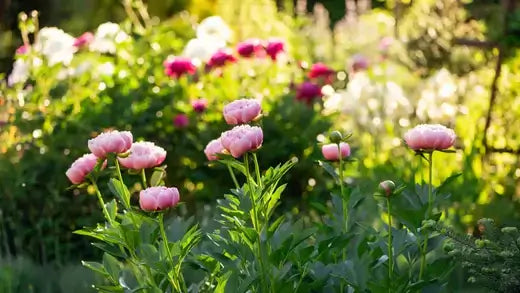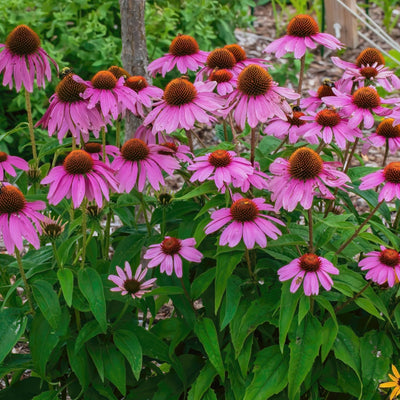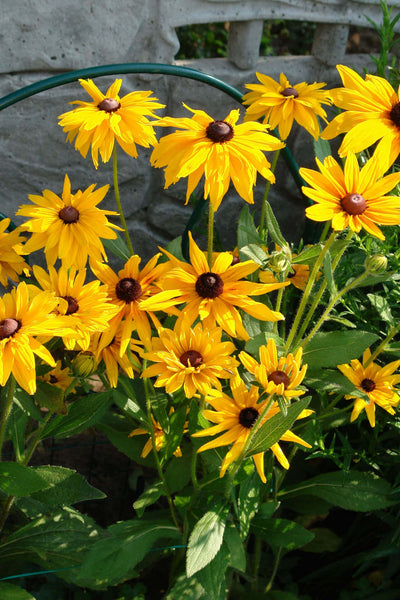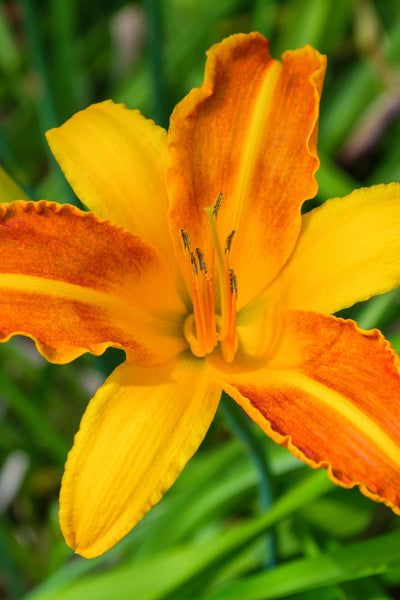The Wondrous Life Cycle of Perennials
More than anybody else, perennial plants help sustain most of the world's finest and most beautiful gardens. Perennials are more than beautiful. They are unique because they come in a variety of colors, shapes, and textures. They help make a backyard or garden's outdoor space an inviting one and come back every year.
Perennials are root hardy, meaning, they are… hardy and sustain themselves. Because of this, they are easy to maintain. Knowing how to grow and care for perennials helps create an enchanting garden. This explainer will go over the most important and most basic elements of growing and tending to perennials in order to help your garden flourish.
Choosing the Right Perennials for Your Garden
The most important part of your perennial garden is choosing the right plants so they can grow and thrive. To do this, the most basic choice of plants will have to depend on your environment. Match the plants and the places in your garden. Think about your zone, the kind of soil you will have, how much sunlight your plants will get, and how you would like your garden to look in the end.
Some perennials love soaking up the sun for about six hours a day. Coneflower (Echinacea) is a cheerful sun-loving expression of purple, the Black-Eyed Susan (Rudbeckia) stands tall and pretty, and the Russian Sage (Perovskia) is a sweet-smelling delight. And what is even better are the bees and butterflies that love visiting the lovely blooms.
Meanwhile, other plants prefer shade, which is often cooler and more comfortable. Hostas are a well-known plant that is ideal for the shade because of their sturdy, decorative leaves that are green, blue, and gold.
If you want a shadely corner of your garden to shine, you can choose flowers like the sweet and small Bleeding Hearts, dieback or hardy ground-covering Astilbe which can bloom large feathery flowers. Choosing which plants you want from this list is fun, you should for sure think about how much sunlight of which type is essential for their long term health.
Getting the Site Ready for Planting
Correct zoning is a very important factor in the success of your planting. Before thinking about digging or dropping a seeding in the soil, make sure that you have prepped the place for planting and have cleared the spot well of the weeds, rocks, or other debris. Weeds will suck out a lot of the water and nutrients from your plants.
Next, look at your dirt. Most perennials like dirt that is loose, dry, and has lots of organic material. If your dirt is a lot of thick clay, you'll need to add stuff like compost, rotted animal manure, or peat moss so that your dirt doesn't hold on to water. This stuff is also good at providing other nutrients.
But, if your dirt is loose and sandy so that water runs through it too quickly, adding any of the above materials will help it hold onto more water. A small soil test will give you precise information about your soil and allow you to create specific improvements.
Planting Perennials
Once the dirt is prepared, you can put in the new plants. While adding new plants, make sure to look at the spacing guidelines that will be on the tag of the plant. While it may look like there is too much space at the start, it stops overcrowding and will help avoid diseases in the future as the plants grow and need more space.
First, dig a hole that matches the depth of the root ball but is slightly wider. Remove the pot the plant is in, and detangle the roots if necessary. Place the plant in the hole and make sure the root ball is level with the soil. Then, add the soil you took out of the hole around the root ball and pack it so that it is free of air and so that the roots are not able to dry out.
Watering, Mulching, and Fertilizing
Watering
Watering the new plants is the most important task that needs to be done. Over the course of the first year, the roots of the new plants will try to secure themselves in the soil. This is when watering is most important.
Make sure to keep the soil damp but not soggy and keep the watering consistent. As the roots get established, the plant's roots will become more resistant to dry soil. During dry periods, make sure to deep water your plants so that the roots grow down. This will make your plant more resilient.
Mulching
You should put a 2-3 inch layer of mulch around your perennials. Shredded bark, wood chips, or straw helps hold moisture in the soil, keeps moisture in the soil, prevents weeds, and keeps the soil temperature the way you want it. Make sure to leave a few inches of space from the plant stems to avoid rot.
Fertilizing
Perennials aren't feeders. A balanced, slow-release fertilizer integrated into the soil when planting will be enough for the first season. If you want to, you can add a layer of compost or old manure around the plants in springs in the following years. Be careful of adding too much fertilizer, though, because it will cause a lot of foliage growth without flowers coming in.
Pruning, Deadheading, and Dividing
Pruning and Deadheading
In order to have the best perennial garden possible, these two tasks are very important. Removing spent flowers, also known as deadheading, improves the appearance of the plant and redirects its energy into producing more flowers.
This has the effect of lengthening the flowering period. Pruning also improves the appearance of the plant by removing the damaged, diseased, and overgrown foliage. This also improves air circulation throughout the plant. Pruning depends on the plant, as some will benefit more from pruning in the fall, while on the other hand some benefit more in early spring.
Maintenance
Dividing is crucial for the longevity of perennial plants and is especially beneficial for plants like Irises and Daylilies. Every so often, you will need to separate the plant into several smaller plants to allow it to maintain its health.
Signs it is time to divide include when the center of the plant begins to die or becomes unproductive for long periods. To separate the plant, dig up the entire plant, then use a knife to cut it into sections, ensuring each section has a good amount of roots and leaves. Then you can use the divisions and plant them to increase your plant stock.
How to Get Your Perennials Ready for Winter
As winter approaches, you have to get your perennials ready for winter. In cold areas, once the ground has frozen, you should add a new layer of mulch. This will help keep the roots safe from extreme temperature variations and frost heave.
For some perennials, insulating the dead leaves and stems will help keep the plant warm and also add some decor to your winter landscape. However, if you are worried dead leaves and stems will have pests or diseases, you can cut the plant back to around a few inches above the ground in the late fall.
Get Going Today On Your Perennial Garden
Planting a successful perennial garden is a process that brings increasingly lovely results year after year ever changing. With the right smidgen of knowledge and a little elbow grease, it's possible for you to have a Mexican Hat 'Maroon Creeper'in flowerbeds that delights year round and never bores.
Are you ready to find the ideal perennials for your garden? Go to the web site of TN Nursery, an online source that offers thousands of healthy, high-quality plants. Have a look at the perennial plants we can send out today!
FAQs
Are you supposed to cut back perennials in the fall?
When to cut perennials back depends on the individual plant and what you are trying to accomplish. Cutting perennials back can help keep the area tidy and prevent dead leaves from harboring diseases. Leaving the dead foliage, however, will help winter over the plant and shelter a few beneficial insects during the winter.
What is the 3 year rule for perennials?
There’s a saying that helps guide people on perennial growth called the 3-year rule. It states that, “In the first year, they sleep. In the second year, they creep. And in the third year, they leap.” In the first year, the perennial plants will focus on growing the root systems. Year two comes with more leaves growth as well as the possible addition of a few flowers. By the third year, the perennial is fully grown and will bloom to the fullest.
How do you maintain perennials?
To maintain perennials, they need ample care and upkeep. When first planted, the perennials need to be watered regularly. In addition to watering, mulch should be added around the plant to help retain moisture. They should be deadheaded, which means cutting off the last flowers for more to grow, and trimmed of their overgrowth. To take care of perennials, their will be a need for cutting back dead growth, which is called foliage. This needs to be done at a certain time of year to be done correctly.
What happens if you don't cut back perennials?
If you do not cut back perennials, it can get a little messy. Plants can hoard bugs, pests, and fungal spores. While it may not look the best, the dead plant foliage actually helps shelter and protect the plant. New plant growth will push through the old foliage when the time is right, but having dead plant matter can make the plant more vulnerable to disease.
How do you winterize perennials?
Once the ground is frozen, it is important to water perennials deeply. Prune the plants to just 3-6 inches after the first hard frost. Once the ground is frozen, cover the tops of the plants with 2-3 inches of mulch to help the roots stay insulated.





